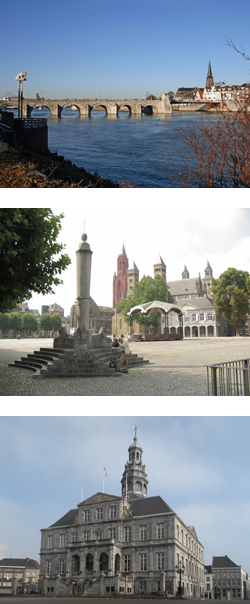
Maastricht is the capital of the province of Limburg and is the oldest city in the Netherlands. Maastricht has a rich history, with a lot of places of interest. Maastricht developed from a Roman settlement to a Medieval religious centre, a garrison town and an early industrial city. Today, Maastricht is well-regarded as an affluent cultural center.
It has become known, by way of the Maastricht Treaty, as the birthplace of the European Union, European citizenship, and the single European currency, the euro. The town is popular with tourists for shopping and recreation, and has a large growing international student population.
Maastricht is known as the birthplace of the Euro currency and the European treaty (1992) which was signed in the caves of the beautiful castle Neercanne. The city of Maastricht is the oldest city of the Netherlands and is ranked the second most beloved city destination straight after Amsterdam. Maastricht offers a wide range of hotels, restaurants, bars and cultural highlife.
Magical Maastricht

Both young and old can have great skating experience on the 800m² skating floor. The skyline of Maastricht can be admired from the Ferris wheel and among others, a nostalgic grand carousel with 2 floors provides entertainment for all ages. Stroll beside the Christmas market in search of original gifts and be surprised by special performances in the charming Vrijthof Pavilion.
Need a break from all the magical impressions? Conquer one place in a heated Christmas terrace overlooking the impressive Basilica of St. Servatius and St. John’s Church and enjoy winter delights such as hot chocolate with whipped cream, donuts, or glühwein.

HISTORY
Maastricht is one of the cities that call themselves “oldest city in the Netherlands.” On the basis of results of archaeological excavations can be said, with certainty, that the city has been inhabited continuously for twenty centuries. Roughly speaking, the history of Maastricht can be divided into four times with four different faces:
Roman fortress, Medieval Religious centre, Garrison city en Early industrial city.

Places of Interest

Maastricht has a rich history with lots of places of interest. Maastricht has 1677 national heritage sites (Rijksmonumenten), which is the second highest number in a Dutch town. The streets still show traces of Maastricht as a Roman fortress, religious center, garrison town and the early industrial city. You can enjoy sightseeing with protected buildings, monuments and other places of interest, both inside and outside the city center, such as:

INSIDE THE CITY CENTER
Meuse, with St. Servaas Bridge (the oldest bridge in the Netherlands), Maaspromenade and parks along the Maas (City Park, Charles Eyck Park and Griendpark);
Vrijthof, with Basilica of Saint Servatius, St. John’s Church, military guardhouse, Generals House, Spanish Government and Perroen;
Onze-Lieve-Vrouweplein, with Our Lady’s Basilica and near, wool weighing house, Bonbonnière and Stokstraatkwartier;
Market, Town Hall Pieter Post and statue of Jean-Pierre Minckelers;
Other Downtown, including Large and Small State, Dinghuis (with tourist office), Dominican Church and Old Government;
Jekerkwartier, including Hellgate, Jeker Tower and parts of the first and second medieval city wall, Bisschopsmolen and Leo Mill (water mills on the Jeker), House on the Jeker, Old Minderbroederskerk, Walloon church, Lutheran church, Bonnefantenklooster, Big Looiersstraat with stately mansions and St. -Martinushofje, and various picturesque streets;
Bassin, inland from 1826 with bridges, locks, warehouses, wharfs and early industrial buildings (KNP, Joinery, Eiffel Building);
Wyck, including Waterpoortje, Mesh Point Tower, Straight Street, St. Martin and the new city Céramique (with Bonnefantenmuseum, Wiebengahal, Centre Céramique and various buildings by internationally renowned architects).
OUTSIDE THE CITY CENTER
City park, park belt including Father Vinck Tower and parts of the 14th-century city wall, late-15th-century bastions hatred income Nijt and the Five Cups, Port Waerachtig, Pest Huys, Jeker, watergate The Reek statue of d’Artagnan and former Bear Pit. Adjacent to the City Park: Waldeckpark with bastion Waldeck;
Riverfront Park, nature reserve with Linie van Du Moulin, 18th-century fortifications with bastions, lunettes, dry trenches and bunkers;
Saint-Pierre, with vast subterranean limestone quarries (cave), which Zonneberg and Northern corridors accessible to visitors. Also on the Saint-Pierre: Fort St. Peter, well outside Slavante and castle ruins Lichtenberg;
Jeker Valley, including Mill Lombok, homestead Nekum, Apostelhoeve (vineyards) and Castle Neercanne;
Estates Zone, nature including Geusselt castle, mansion Mariënwaard Castle Bethlehem, Jerusalem castle, castle Vaeshartelt Castle Meerssenhoven, homestead Hartelstein and castle Borgharen
Further, examples of interesting 20th-century architecture, including Saint-Lambert (in Romano-Byzantine style with brass helmet roofs), Koepelkerk (modernist church with its imposing dome), several buildings from the first half of the 20th century by Frits Peutz and Alphons boost, some more recent buildings by Jo Coenen and Wiel Arets architecture Céramique district and the Government on the Maas (Limburg province house).

Celebreties
Maastricht has plenty of celebrities. Musicians, athletes, politicians and lawyers are just a few examples of professions in which the most famous of Maastricht are or were active. A handful of examples of famous Maastricht people that everybody knows: Andre Rieu, Tom Dumoulin, Baldwin Senden, Frans Timmermans and Bram Moszkowicz. But there are so much more …

For more information about Maastricht, we refer you to the VVV Maastricht.
